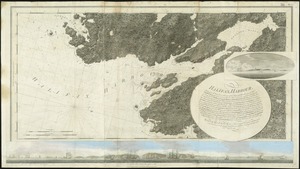A draught of the harbour of Hallifax and the adjacent coast in Nova Scotia
This map is also available in American Revolutionary Geographies Online (ARGO), a collections portal especially built for material relating to the American Revolutionary War Era. Visit ARGO to learn more about this item and explore the historical geography of North America in the late eighteenth century.
Item Information
- Title:
- A draught of the harbour of Hallifax and the adjacent coast in Nova Scotia
- Description:
-
We Are One: Surveyor James Cook worked with Surveyor General Samuel Holland to map the new British territories in Canada after the French and Indian War. Cook created this map of Halifax in 1766. Previously, the fortress at Louisbourg on Cape Breton Island was the principal French settlement in Nova Scotia. During the French and Indian War, however, the British successfully used Halifax as a counterforce to Louisbourg. Halifax served as a British naval base throughout the war and became Nova Scotia’s major city and port after the British victory.
- Creator:
- Cook, James, active 1762-1775
- Name on Item:
-
survey'd by order of Commodore Spry, by James Cook ; Emanl. Bowen sculpt.
- Date:
-
1766
- Format:
-
Maps/Atlases
- Location:
-
Boston Public Library
Norman B. Leventhal Map & Education Center - Collection (local):
-
Norman B. Leventhal Map & Education Center Collection
- Subjects:
-
Halifax Harbour (N.S.)--Maps--Early works to 1800
Nova Scotia--Maps--Early works to 1800
- Places:
-
CanadaNova Scotia (province)Halifax Harbour (harbor)
- Extent:
- 1 chart col. ; 52 x 58 cm.
- Terms of Use:
-
No known copyright restrictions.
No known restrictions on use.
- Publisher:
-
[London] :
James Cook
- Scale:
-
Scale not given.
- Language:
-
English
- Notes:
-
Relief shown by hachures.
Depths shown by soundings.
Includes references.
"Humbly dedicated to Henry Ellis Esqr. F.R.S. late Governor of Nova Scotia."
The cartographer of this map, Master James Cook of the surveying ships Mars (1762-1763) and Alarm (1763-1766), should not be confused with the explorer Captain James Cook (1728-1779), who mapped Newfoundland and made 3 voyages to the Pacific Ocean.
This map can be viewed as a georeferenced overlay in an interactive application made especially for We Are One: Mapping America's Road from Revolution to Independence http://d2o8owo4k087al.cloudfront.net/index.html?mapId=46.
- Notes (citation):
-
Kershaw, K.A. Early printed maps of Canada, v. 3, no. 827
- Notes (exhibitions):
-
Exhibited: "We Are One: Mapping America's Road from Revolution to Independence" organized by the Norman B. Leventhal Map Center at the Boston Public Library, 2015.
- Identifier:
-
06_01_003751
- Call #:
-
G3422.H3 1766 .C66
- Barcode:
-
39999059001857





